 |
EARLY CHRISTIAN ARCHITECTURE:INTRODUCTORY, RAVENNA |
| << ROMAN ARCHITECTURE—Continued:IMPERIAL ARCHITECTURE |
| BYZANTINE ARCHITECTURE:DOMES, DECORATION, CARVED DETAILS >> |
CHAPTER
X.
EARLY
CHRISTIAN ARCHITECTURE.
BOOKS RECOMMENDED: Bunsen, Die
Basiliken christlichen Roms.
Butler, Architecture
and
other Arts in Northern
Central Syria.
Corroyer, L'architecture
romane.
Cummings,
A
History of Architecture in
Italy.
Essenwein (Handbuch d. Architektur),
Ausgänge
der
klassischen
Baukunst.
Gutensohn u. Knapp, Denkmäler
der christlichen Religion.
Hübsch,
Monuments
de l'architecture chrétienne.
Lanciani, Pagan
and Christian Rome.
Mothes,
Die
Basilikenform bei den
Christen,
etc. Okely, Development
of Christian
Architecture
in Italy. Von
Quast, Die
altchristlichen Bauwerke zu
Ravenna. De
Rossi,
Roma
Sotterranea. De
Vogüé, Syrie
Centrale;
Églises
de la Terre Sainte.
INTRODUCTORY.
The
official recognition of Christianity in
the year 328 by
Constantine
simply legalized an institution which had
been for three
centuries
gathering
momentum for its final conquest of the
antique world. The new religion
rapidly
enlisted in its service for a
common purpose and under a common
impulse
races
as wide apart in blood and
culture as those which had built up the art
of
imperial
Rome. It was Christianity which
reduced to civilization in the West
the
Germanic
hordes that had overthrown Rome,
bringing their fresh and
hitherto
untamed
vigor to the task of recreating
architecture out of the decaying
fragments of
classic
art. So in the East its life-giving
influence awoke the slumbering
Greek art-
instinct
to new triumphs in the arts of building,
less refined and perfect
indeed, but
not
less sublime than those of the
Periclean age. Long before
the Constantinian edict,
the
Christians in the Eastern provinces had
enjoyed substantial freedom of
worship.
Meeting
often in the private basilicas of wealthy
converts, and finding these, and
still
more
the great public basilicas,
suited to the requirements of their
worship, they
early
began to build in imitation of these
edifices. There are many
remains of these
early
churches in northern Africa and central
Syria.
EARLY
CHRISTIAN ART IN ROME. This
was at first wholly sepulchral,
developing
in
the catacombs the symbols of the new faith.
Once liberated, however,
Christianity
appropriated
bodily for its public rites
the basilica-type and the general
substance of
Roman
architecture. Shafts and capitals,
architraves and rich linings of
veined
marble,
even the pagan Bacchic
symbolism of the vine, it adapted to new
uses in its
own
service. Constantine led the way in
architecture, endowing Bethlehem
and
Jerusalem
with splendid churches, and his new
capital on the Bosphorus with the
first
of the three historic basilicas
dedicated to the Holy Wisdom (Hagia
Sophia). One
of
the greatest of innovators, he seems to
have had a special predilection for
circular
buildings,
and the tombs and baptisteries which he
erected in this form, especially
that
for his sister Constantia in
Rome (known as Santa Costanza,
Fig. 66), furnished
the
prototype for numberless Italian
baptisteries in later
ages.
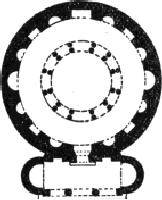
FIG.
66.--STA. COSTANZA, ROME.
The
Christian basilica (see
Figs. 67, 68) generally comprised a
broad and lofty nave,
separated
by rows of columns from the single or
double side-aisles. The aisles
had
usually
about half the width and height of the
nave, and like it were
covered with
wooden
roofs and ceilings. Above the
columns which flanked the nave
rose the lofty
clearstory
wall, pierced with windows above the
side-aisle roofs and supporting
the
immense
trusses of the roof of the nave. The
timbering of the latter was
sometimes
bare,
sometimes concealed by a richly panelled
ceiling, carved, gilded, and
painted.
At
the further end of the nave was the
sanctuary or apse, with the seats for
the
clergy
on a raised platform, the bema, in front of
which was the altar.
Transepts
sometimes
expanded to right and left before the
altar, under which was the confessio
or
shrine of the titular saint or
martyr.
An
atrium
or
forecourt surrounded by a covered
arcade preceded the basilica
proper,
the
arcade at the front of the church forming a
porch or narthex, which,
however, in
some
cases existed without the atrium. The
exterior was extremely
plain; the interior,
on
the contrary, was resplendent with
incrustations of veined marble and
with
sumptuous
decorations in glass mosaic
(called opus
Grecanicum) on a
blue or golden
ground.
Especially rich were the half-dome of the
apse and the wall-space
surrounding
its arch and called the
triumphal
arch; next in
decorative importance
came
the broad band of wall beneath the
clearstory windows. Upon these
surfaces
the
mosaic-workers wrought with minute cubes of
colored glass pictures and
symbols
almost
imperishable, in which the glow of color
and a certain decorative grandeur
of
effect
in the composition went far to atone for the uncouth
drawing. With growing
wealth
and an increasingly elaborate ritual, the furniture
and equipments of the
church
assumed greater architectural
importance. A large rectangular
space was
retained
for the choir in front of the bema, and
enclosed by a breast-high parapet
of
marble,
richly inlaid. On either side
were the pulpits or ambones
for the
Gospel and
Epistle.
A lofty canopy was built over the
altar, the baldaquin,
supported on four
marble
columns. A few basilicas were built with
side-aisles, in two stories, as in
S.
Lorenzo and Sta. Agnese.
Adjoining the basilica in the earlier
examples were the
baptistery
and the tomb of the saint, circular or
polygonal buildings usually; but
in
later
times these were replaced by
the font or baptismal chapel in the church and
the
confessio
under the
altar.
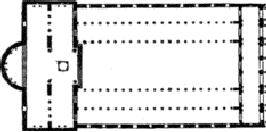
FIG.
67.--PLAN OF THE BASILICA OF
ST. PAUL.
Of
the two Constantinian basilicas in Rome,
the one dedicated to St.
Peter was
demolished
in the fifteenth century; that of
St.
John Lateran has
been so disfigured
by
modern alterations as to be
unrecognizable. The former of the two
adjoined the
site
of the martyrdom of St. Peter in the
circus of Caligula and Nero; it
was five-
aisled,
380 feet in length by 212 feet in width.
The nave was 80 feet wide
and 100
feet
high, and the disproportionately high
clearstory wall rested on
horizontal
architraves
carried by columns. The impressive
dimensions and simple plan of this
structure
gave it a majesty worthy of its rank as
the first church of Christendom.
St.
Paul
beyond the Walls (S.
Paolo fuori le mura), built in 386 by
Theodosius,
resembled
St. Peter's closely in plan
(Figs. 67, 68). Destroyed by fire in
1821, it has
been
rebuilt with almost its
pristine splendor, and is, next to the
modern St. Peter's
and
the Pantheon, the most impressive
place of worship in Rome.
Santa
Maria
its
original aspect, its
Renaissance ceiling happily
harmonizing with its
simple
antique
lines. Ionic columns support
architraves to carry the clearstory, as
in St.
Peter's.
In most other examples, St.
Paul's included, arches turned from
column to
column
perform this function. The first known
case of such use of classic
columns as
arch-bearers
was in the palace of Diocletian at
Spalato; it also appears in
Syrian
buildings
of the third and fourth centuries A.D.
The
basilica remained the model for
ecclesiastical architecture in Rome,
without
noticeable
change either of plan or detail, until
the time of the Renaissance. All
the
earlier
examples employed columns and
capitals taken from ancient
ruins, often
incongruous
and ill-matched in size and order.
San
Clemente (1084)
has retained
almost
intact its early aspect,
its choir-enclosure, baldaquin, and
ambones having
been
well preserved or carefully restored.
Other important basilicas are
mentioned in
the
list of monuments on pages 118,
119.
RAVENNA.
The fifth and
sixth centuries endowed
Ravenna with a number of notable
buildings
which, with the exception of the cathedral,
demolished in the last century,
have
been preserved to our day. Subdued by the
Byzantine emperor Justinian in
537,
Ravenna
became the meeting-ground for Early
Christian and Byzantine traditions
and
the
basilican and circular plans
are both represented. The two churches
dedicated to
St.
Apollinaris, S.
Apollinare Nuovo (520) in the
city, and S.
Apollinare in Classe
(538)
three miles distant from the city, in
what was formerly the port, are
especially
interesting
for their fine mosaics, and for the
impost-blocks interposed above
the
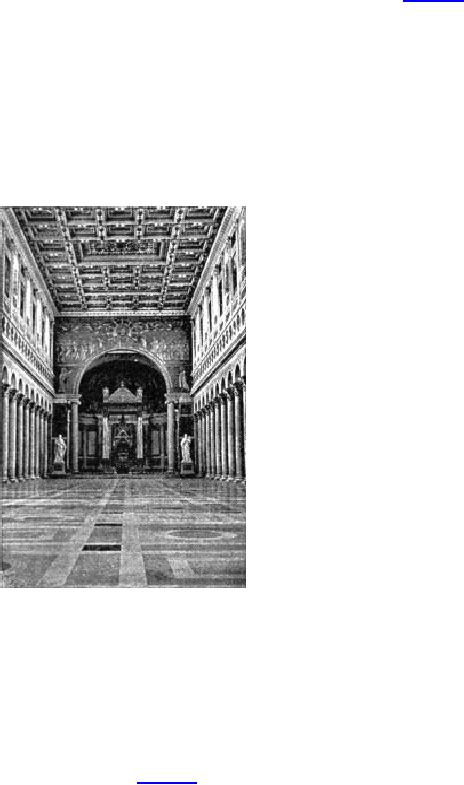
capitals
of their columns to receive the springing
of the pier-arches. These
blocks
appear
to be somewhat crude modifications of the
fragmentary architraves or
entablatures
employed in classic Roman
architecture to receive the springing
of
The
use of external arcading to
give some slight adornment
to the walls of the second
of
the above-named churches, and the round
bell-towers of brick which adjoined
both
of
them, were first steps
toward the development of the "wall-veil" or
arcaded
decoration,
and of the campaniles, which in later
centuries became so
characteristic
of
north Italian churches (see Chapter XIII.). In
Rome the campaniles which
accompany
many of the mediæval basilicas are
square and pierced with many
windows.
FIG.
68.--ST. PAUL BEYOND THE
WALLS. INTERIOR.
The
basilican form of church became general
in Italy, a large proportion of
whose
churches
continued to be built with wooden roofs
and with but slight deviations
from
the
original type, long after
the appearance of the Gothic style. The
chief departures
from
early precedent were in the
exterior, which was embellished with
marble
incrustations
as in S. Miniato (Florence); or with successive
stories of wall-arcades,
as
in many churches in Pisa and Lucca
(see Fig.
90);
until finally the introduction of
clustered
piers, pointed arches, and
vaulting, gradually transformed the
basilican into
the
Italian Romanesque and Gothic
styles.
SYRIA
AND THE EAST. In
Syria, particularly the central
portion, the Christian
architecture
of the 3d to 8th centuries produced a number of very
interesting
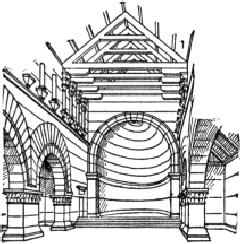
monuments.
The churches built by Constantine in
Syria--the Church of the Nativity
in
Bethlehem (nominally built by his
mother), of the Ascension at Jerusalem,
the
magnificent
octagonal church on the site of the
Temple, and finally the somewhat
similar
church at Antioch--were the most notable
Christian monuments in Syria.
The
first
three on the list, still
extant in part at least,
have been so altered by
later
additions
and restorations that their original
forms are only approximately
known
from
early descriptions. They were all of
large size, and the octagonal church on
the
marble
incrustations of the early design
are still visible in the
"Mosque of Omar,"
but
most of the old work is concealed by the
decoration of tiles applied by
the
Moslems,
and the whole interior aspect altered by
the wood-and-plaster dome with
which
they replaced the simpler roof of the
original.
FIG.
69.--CHURCH AT KALB
LOUZEH.
Christian
architecture in Syria soon,
however, diverged from Roman
traditions. The
abundance
of hard stone, the total lack of
clay or brick, the remoteness from
Rome,
led
to a peculiar independence and
originality in the forms and details of
the
ecclesiastical
as well as of the domestic architecture of
central Syria. These
innovations
upon Roman models resulted in the
development of distinct types
which,
but
for the arrest of progress by the
Mohammedan conquest in the seventh
century,
would
doubtless have inaugurated a new and
independent style of architecture.
Piers
of
masonry came to replace the
classic column, as at Tafkha (third or fourth
century),
Rouheiha
and Kalb Louzeh (fifth century?
Fig. 69); the ceilings in the
smaller
churches
were often formed with stone
slabs; the apse was at first
confined within
the
main rectangle of the plan, and was
sometimes square. The exterior
assumed a
striking
and picturesque variety of forms by
means of turrets, porches, and
gables.
Singularly
enough, vaulting hardly appears at all,
though the arch is used with
fine
effect.
Conventional and monastic groups of
buildings appear early in
Syria, and that
of
St.
Simeon Stylites at
Kelat Seman is an impressive and
interesting monument.
Four
three-aisled wings form the arms of a
cross, meeting in a central
octagonal open
court,
in the midst of which stood the column of the
saint. The eastern arm of the
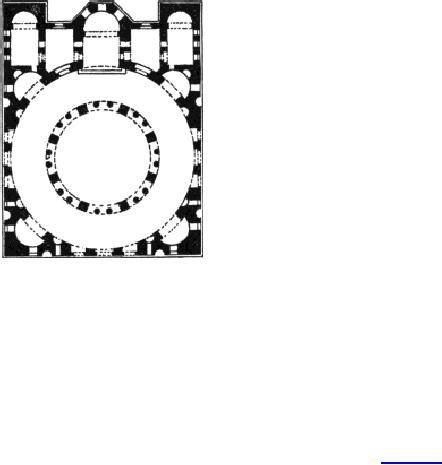
cross
forms a complete basilica of
itself, and the whole cross
measures 330 × 300
feet.
Chapels, cloisters, and cells
adjoin the main edifice.
FIG.
70.--CATHEDRAL AT BOZRAH.
Circular
and polygonal plans appear in a number of
Syrian examples of the
early
sixth
century. Their most striking
feature is the inscribing of the circle
or polygon in
a
square which forms the exterior
outline, and the use of four niches to
fill out the
corners.
This occurs at Kelat Seman in a
small double church, perhaps the tomb
and
chapel
of a martyr; in the cathedral at Bozrah
(Fig.
70), and in the small domical
church
of St.
George at
Ezra.
These were probably the
prototypes of many Byzantine
though
the exact dates of the Syrian
churches are not known. The one at
Ezra is the
only
one of the three which has a
dome, the others having been
roofed with wood.
The
interesting domestic architecture of
this period is preserved in whole towns
and
villages
in the Hauran, which, deserted at the Arab
conquest, have never
been
reoccupied
and remain almost intact but for the
decay of their wooden roofs.
They
are
marked by dignity and simplicity of
design, and by the same picturesque
massing
of
gables and roofs and porches which
has already been remarked of
the churches.
The
arches are broad, the
columns rather heavy, the
mouldings few and simple, and
the
scanty carving vigorous and
effective, often strongly
Byzantine in type.
Elsewhere
in the Eastern world are many early
churches of which even the
enumeration
would exceed the limits of this work.
Salonica counts a number of
basilicas
and several domical churches. The church
of St.
George, now a
mosque, is
of
early date and thoroughly
Roman in plan and section, of the same
class with the
Pantheon
and the tomb of Helena, in both of which a massive
circular wall is
lightened
by eight niches. At Angora
(Ancyra), Hierapolis, Pergamus, and
other
points
in Asia Minor; in Egypt, Nubia, and
Algiers, are many examples of
both
circular
and basilican edifices of the early
centuries of Christianity. In
Constantinople
there
remains but a single representative of
the basilican type, the church of
St.
John
Studius, now the
Emir Akhor mosque.

MONUMENTS:
ROME: 4th century: St. Peter's,
Sta. Costanza, 330?; Sta.
Pudentiana,
335
(rebuilt 1598); tomb of St.
Helena; Baptistery of Constantine;
St. Paul's beyond
the
Walls,
386; St. John Lateran
(wholly remodelled in modern
times). 5th century:
Baptistery
of St. John Lateran; Sta.
Sabina, 425; Sta. Maria
Maggiore, 432; S. Pietro in
Vincoli,
442 (greatly altered in modern
times). 6th century: S. Lorenzo, 580
(the older
portion
in two stories); SS. Cosmo e
Damiano. 7th century: Sta.
Agnese, 625; S. Giorgio
in
Velabro, 682. 8th century: Sta.
Maria in Cosmedin; S. Crisogono. 9th
century:
S.
Nereo ed Achilleo; Sta.
Prassede; Sta. Maria in
Dominica. 12th and 13th
centuries:
S.
Clemente, 1118; Sta. Maria in
Trastevere; S. Lorenzo (nave);
Sta. Maria in Ara
Coeli.
RAVENNA:
Baptistery of S. John, 400 (?); S.
Francesco; S. Giovanni Evangelista, 425;
Sta.
Agata,
430; S. Giovanni Battista, 439; tomb of
Galla Placidia, 450; S. Apollinare
Nuovo,
500520;
S. Apollinare in Classe, 538; St.
Victor; Sta. Maria in
Cosmedin (the Arian
Baptistery);
tomb of Theodoric (Sta.
Maria della Rotonda, a
decagonal two-storied
mausoleum,
with a low dome cut from a
single stone 36 feet in
diameter), 530540.
ITALY IN GENERAL:
basilica at Parenzo, 6th century;
cathedral and Sta. Fosca at
Torcello,
640700;
at Naples Sta. Restituta, 7th
century; others, mostly of
10th-13th centuries, at
Murano
near Venice, at Florence (S.
Miniato), Spoleto, Toscanella,
etc.; baptisteries at
Asti,
Florence, Nocera dei Pagani,
and other places. IN SYRIA AND THE
EAST:
basilicas of
the
Nativity at Bethlehem, of the
Sepulchre and of the
Ascension at Jerusalem;
also
polygonal
church on Temple platform;
these all of 4th century.
Basilicas at Bakouzah,
Hass,
Kelat Seman, Kalb Louzeh,
Rouheiha, Tourmanin, etc.;
circular churches,
tombs,
and
baptisteries at Bozrah, Ezra,
Hass, Kelat Seman, Rouheiha,
etc.; all these
4th-8th
centuries.
Churches at Constantinople (Holy
Wisdom, St. John Studius,
etc.), Hierapolis,
Pergamus,
and Thessalonica (St.
Demetrius, "Eski Djuma"); in
Egypt and Nubia
(Djemla,
Announa,
Ibreem, Siout, etc.); at
Orléansville in Algeria. (For
churches, etc., of
8th-10th
centuries
in the West, see Chapter
XIII.)
15.
Hereafter
the abbreviation S. M. will be generally
used instead of the
name
Santa
Maria.
16.
Fergusson
(History
of Architecture,
vol. ii., pp. 408, 432) contends that
this
was
the real Constantinian
church of the Holy Sepulchre,
and that the one
called
to-day
by that name was erected by
the Crusaders in the twelfth
century. The more
general
view is that the latter
was originally built by Constantine as
the Church of
the
Sepulchre, though subsequently
much altered, and that
the octagonal edifice
was
also his work, but erected
under some other name.
Whether this church
was
later
incorporated in the "Mosque of
Omar," or merely furnished
some of the
materials
for its construction, is not quite
clear.
Table of Contents:
- PRIMITIVE AND PREHISTORIC ARCHITECTURE:EARLY BEGINNINGS
- EGYPTIAN ARCHITECTURE:LAND AND PEOPLE, THE MIDDLE EMPIRE
- EGYPTIAN ARCHITECTURE—Continued:TEMPLES, CAPITALS
- CHALDÆAN AND ASSYRIAN ARCHITECTURE:ORNAMENT, MONUMENTS
- PERSIAN, LYCIAN AND JEWISH ARCHITECTURE:Jehovah
- GREEK ARCHITECTURE:GENERAL CONSIDERATIONS, THE DORIC
- GREEK ARCHITECTURE—Continued:ARCHAIC PERIOD, THE TRANSITION
- ROMAN ARCHITECTURE:LAND AND PEOPLE, GREEK INFLUENCE
- ROMAN ARCHITECTURE—Continued:IMPERIAL ARCHITECTURE
- EARLY CHRISTIAN ARCHITECTURE:INTRODUCTORY, RAVENNA
- BYZANTINE ARCHITECTURE:DOMES, DECORATION, CARVED DETAILS
- SASSANIAN AND MOHAMMEDAN ARCHITECTURE:ARABIC ARCHITECTURE
- EARLY MEDIÆVAL ARCHITECTURE:LOMBARD STYLE, FLORENCE
- EARLY MEDIÆVAL ARCHITECTURE.—Continued:EARLY CHURCHES, GREAT BRITAIN
- GOTHIC ARCHITECTURE:STRUCTURAL PRINCIPLES, RIBBED VAULTING
- GOTHIC ARCHITECTURE IN FRANCE:STRUCTURAL DEVELOPMENT
- GOTHIC ARCHITECTURE IN GREAT BRITAIN:GENERAL CHARACTER
- GOTHIC ARCHITECTURE IN GERMANY, THE NETHERLANDS, AND SPAIN
- GOTHIC ARCHITECTURE IN ITALY:CLIMATE AND TRADITION, EARLY BUILDINGS.
- EARLY RENAISSANCE ARCHITECTURE IN ITALY:THE CLASSIC REVIVAL, PERIODS
- RENAISSANCE ARCHITECTURE IN ITALY—Continued:BRAMANTE’S WORKS
- RENAISSANCE ARCHITECTURE IN FRANCE:THE TRANSITION, CHURCHES
- RENAISSANCE ARCHITECTURE IN GREAT BRITAIN AND THE NETHERLANDS
- RENAISSANCE ARCHITECTURE IN GERMANY, SPAIN, AND PORTUGAL
- THE CLASSIC REVIVALS IN EUROPE:THE EIGHTEENTH CENTURY
- RECENT ARCHITECTURE IN EUROPE:MODERN CONDITIONS, FRANCE
- ARCHITECTURE IN THE UNITED STATES:GENERAL REMARKS, DWELLINGS
- ORIENTAL ARCHITECTURE:INTRODUCTORY NOTE, CHINESE ARCHITECTURE
- APPENDIX.